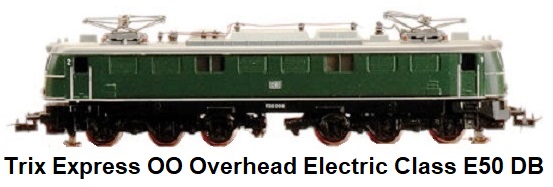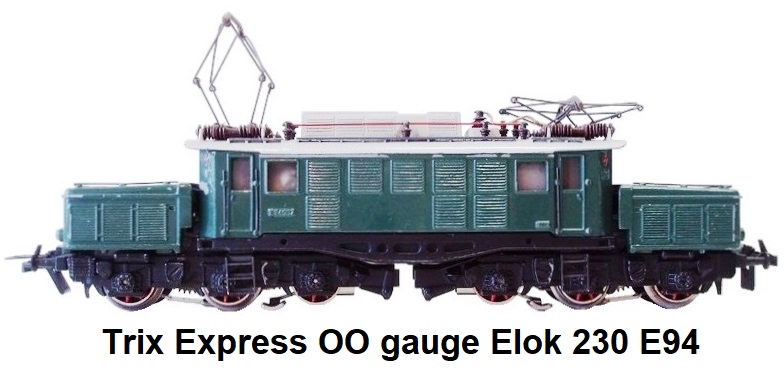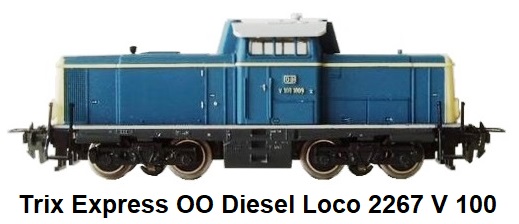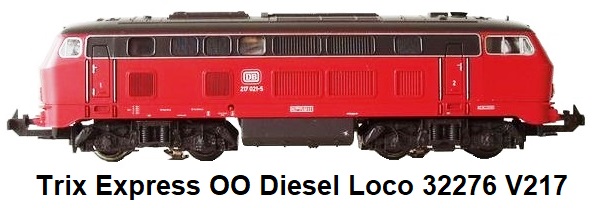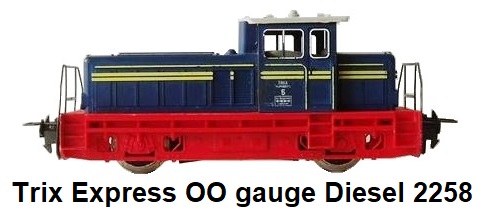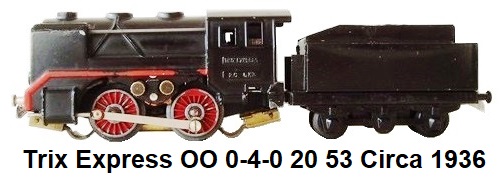 Trix evolved from two tin toy companies, one founded in 1838 by Johann Haffner, the other in 1899 by Andreas Förtner.
After Förtner died in 1922, the two businesses merged to become Vereinigte Spielwarenfabriken (United Toy Company). Based
in Nüremburg Germany, the Fortner & Haffner company made metal
construction sets, tin figures and metal play goods. The name Trix first appeared in 1931 and was derived from the construction sets they produced.
The metal strips in these sets had holes for the bolts arranged
in an X-shaped pattern with 3 holes in each arm i.e. Tri - X. In 1935 the company began producing the
electrically powered model trains that it became famous for, under the Trix Express label. These trains
were produced under the guidance of former Bing managing
director Stephan Bing. Bing had left the family business in 1927 and purchased this firm. He partnered with
Herrmann Oppenheim and Siegfried Kahn. Initial
production of trains was in 'OO' gauge for three rail track, operating at 14 volts AC. OO was a scale that the Bing company itself
had also made in the 1920's.
Trix evolved from two tin toy companies, one founded in 1838 by Johann Haffner, the other in 1899 by Andreas Förtner.
After Förtner died in 1922, the two businesses merged to become Vereinigte Spielwarenfabriken (United Toy Company). Based
in Nüremburg Germany, the Fortner & Haffner company made metal
construction sets, tin figures and metal play goods. The name Trix first appeared in 1931 and was derived from the construction sets they produced.
The metal strips in these sets had holes for the bolts arranged
in an X-shaped pattern with 3 holes in each arm i.e. Tri - X. In 1935 the company began producing the
electrically powered model trains that it became famous for, under the Trix Express label. These trains
were produced under the guidance of former Bing managing
director Stephan Bing. Bing had left the family business in 1927 and purchased this firm. He partnered with
Herrmann Oppenheim and Siegfried Kahn. Initial
production of trains was in 'OO' gauge for three rail track, operating at 14 volts AC. OO was a scale that the Bing company itself
had also made in the 1920's.
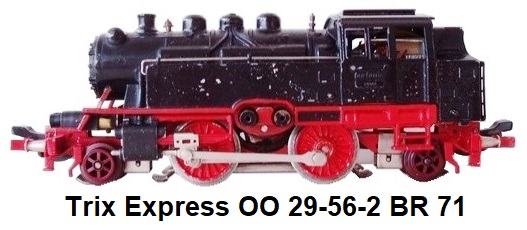
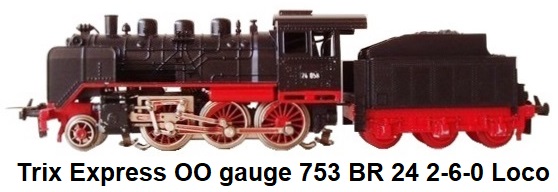

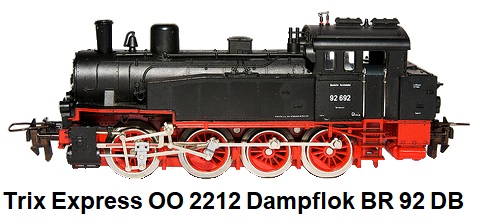
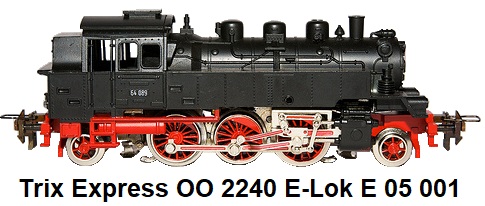 Prior to the outbreak of World War II the Trix company produced a small range of fairly unrealistic
AC powered 3-rail models running at 14 volts. The track current was reduced and controlled
via means of a transformer or via batteries. United Toy subsequently introduced the innovative Trix Twin system.
Unlike other manufacturers of the period, Trix allowed two trains to run on the same track simultaneously
under independent control, one collecting current from the left rail and centre, the other from the
right and centre. This system was known as 'Trix Twin' in the United Kingdom where from 1936 British outline models were
Prior to the outbreak of World War II the Trix company produced a small range of fairly unrealistic
AC powered 3-rail models running at 14 volts. The track current was reduced and controlled
via means of a transformer or via batteries. United Toy subsequently introduced the innovative Trix Twin system.
Unlike other manufacturers of the period, Trix allowed two trains to run on the same track simultaneously
under independent control, one collecting current from the left rail and centre, the other from the
right and centre. This system was known as 'Trix Twin' in the United Kingdom where from 1936 British outline models were
 made by a subsidiary - Trix Limited. These were distributed directly but also by
Bassett-Lowke under the brand name
'Twin Train Table Railway', initially using German outline models painted in British colors
from 1935 onwards. The early models were relatively crude but became more realistic following new designs
by Henry Greenly a
well known model railway designer employed by Bassett-Lowke. Hence some boxes have the dual name
“Trix Ltd and Bassett-Lowke
scale models” from 1937 to 1939. The first locos appeared with solid wheels. Later on more realistic spoked wheels were introduced.
In 1937 new English-made body castings were manufactured in the style of British rather than German steam locos. These locos, along
with British rolling stock, were on sale in LNER, LMS, and Southern liveries. In addition to tender locos, tank locos were also
produced in passenger and goods liveries. Joseph Wenman Bassett-Lowke and
the Bing family had a long standing relationship, with the Gerbrüder Bing company building many of the Bassett-Lowke
locomotives and carriages in the early part of the 20th century. It was actually W. J. Bassett-Lowke who had persuaded
Bing to develop the smaller sized train in 1920 called 'Bing's Table Railway' in OO gauge.
made by a subsidiary - Trix Limited. These were distributed directly but also by
Bassett-Lowke under the brand name
'Twin Train Table Railway', initially using German outline models painted in British colors
from 1935 onwards. The early models were relatively crude but became more realistic following new designs
by Henry Greenly a
well known model railway designer employed by Bassett-Lowke. Hence some boxes have the dual name
“Trix Ltd and Bassett-Lowke
scale models” from 1937 to 1939. The first locos appeared with solid wheels. Later on more realistic spoked wheels were introduced.
In 1937 new English-made body castings were manufactured in the style of British rather than German steam locos. These locos, along
with British rolling stock, were on sale in LNER, LMS, and Southern liveries. In addition to tender locos, tank locos were also
produced in passenger and goods liveries. Joseph Wenman Bassett-Lowke and
the Bing family had a long standing relationship, with the Gerbrüder Bing company building many of the Bassett-Lowke
locomotives and carriages in the early part of the 20th century. It was actually W. J. Bassett-Lowke who had persuaded
Bing to develop the smaller sized train in 1920 called 'Bing's Table Railway' in OO gauge.




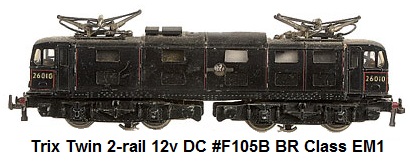 Stephan Bing had established a UK subsidiary in 1932 called Trix Ltd. and put his son Franz in charge as director.
Initially this company marketed and produced the construction sets, not the trains. However, Bing and his management team,
who were all Jewish, were forced to flee Germany after the company there was taken over by the Nazi Socialist
Stephan Bing had established a UK subsidiary in 1932 called Trix Ltd. and put his son Franz in charge as director.
Initially this company marketed and produced the construction sets, not the trains. However, Bing and his management team,
who were all Jewish, were forced to flee Germany after the company there was taken over by the Nazi Socialist
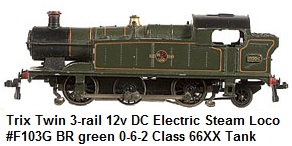 regime under Adolph Hitler in 1938. They all emigrated to England where the British company continued
the manufacture of British Trix trains at a
Northampton factory under the Trix Ltd. name. This company concentrated production on English outline trains.
In 1938 Trix Ltd. brought out their first Pacific locomotives, but this was the year that rival Hornby
launched its Hornby Dublo system with its better looking models. The Trix LNER Pacifics were made to OO scale, however, all other
Trix products were smaller. Trix had a habit of making things to their own scale over the years. A scale of 3.8mm/ft. was utilized,
which is actually in between OO and HO scale. When placed beside OO scale models produced by other manufacturers the Trix trains did not look correct.
regime under Adolph Hitler in 1938. They all emigrated to England where the British company continued
the manufacture of British Trix trains at a
Northampton factory under the Trix Ltd. name. This company concentrated production on English outline trains.
In 1938 Trix Ltd. brought out their first Pacific locomotives, but this was the year that rival Hornby
launched its Hornby Dublo system with its better looking models. The Trix LNER Pacifics were made to OO scale, however, all other
Trix products were smaller. Trix had a habit of making things to their own scale over the years. A scale of 3.8mm/ft. was utilized,
which is actually in between OO and HO scale. When placed beside OO scale models produced by other manufacturers the Trix trains did not look correct.
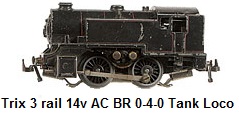
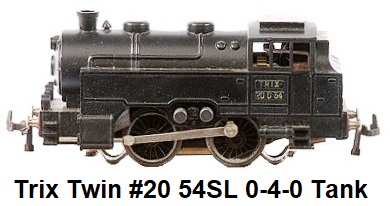
 In order to retain rights to manufacture Trix trains in England, Bing agreed to pay a licence fee to the German
company as well as guaranteed
to make a minimum amount of purchases from the German company. The German and English companies
continued to work together right up to
the end of 1939, some components such as motors used in all the English locomotives were made in Germany. Until the
beginning of the Second World War, the German and English companies shared close business ties, supplying one another with parts.
Patents were taken out in both countries but under either company’s name. German made Trix Express locomotives were imported to England,
the bodies were removed, the red wheels painted black and English bodies were mounted. Trix engines were constructed in die-cast metal, while the
rolling stock was made of tinplate. The Trix Express
goods wagon chassis were also utilized. The British range of pre-war coaches included 4-wheel suburban types, in LNER and LMS colors,
and also bogie coaches. Wagons available included tankers, covered vans, timber trucks, coal,
and bogie types. Pre-war rolling stock couplings were the cast metal hook and wire type. Trix also produced a range of stations, signal boxes,
platforms, and other lineside accessories, in wood and metal.
In order to retain rights to manufacture Trix trains in England, Bing agreed to pay a licence fee to the German
company as well as guaranteed
to make a minimum amount of purchases from the German company. The German and English companies
continued to work together right up to
the end of 1939, some components such as motors used in all the English locomotives were made in Germany. Until the
beginning of the Second World War, the German and English companies shared close business ties, supplying one another with parts.
Patents were taken out in both countries but under either company’s name. German made Trix Express locomotives were imported to England,
the bodies were removed, the red wheels painted black and English bodies were mounted. Trix engines were constructed in die-cast metal, while the
rolling stock was made of tinplate. The Trix Express
goods wagon chassis were also utilized. The British range of pre-war coaches included 4-wheel suburban types, in LNER and LMS colors,
and also bogie coaches. Wagons available included tankers, covered vans, timber trucks, coal,
and bogie types. Pre-war rolling stock couplings were the cast metal hook and wire type. Trix also produced a range of stations, signal boxes,
platforms, and other lineside accessories, in wood and metal.


 From 1939 to 1945 British Trix train production at the Winteringham facility was halted and manufacturing concentrated
on assisting the war effort.
Stephan Bing passed away in 1940 before the end of World War II.
His son Franz and daughter Lilli continued operation of the British company through 1957.
By 1948 the British Trix trains were again being produced. Some unsold pre-war items were also sold post-war.
Two AC 4-4-0 locos were produced both pre- and post-war in various liveries. It was at this time that the fateful decision was made to stick with
14V AC 3-rail operation and coarse wheels, for the sake of existing customers. This was a decision that would condemn Trix to a very
slow death and to bankrupt a line of ownership companies along the way. The 14 volt motored locos will run on 12 volts DC, but the reversing mechanism
will not operate properly. Export was the first priority after the war and American outline
models were produced. Two American locos were available using the 4-wheel AC mechanism, a passenger model with cowcatcher,
and a freight switcher. Primarily for export to the US and Australia, these locos were also sold in the UK with American style
rolling stock. However, shortage of materials was the company’s biggest problem.
From 1939 to 1945 British Trix train production at the Winteringham facility was halted and manufacturing concentrated
on assisting the war effort.
Stephan Bing passed away in 1940 before the end of World War II.
His son Franz and daughter Lilli continued operation of the British company through 1957.
By 1948 the British Trix trains were again being produced. Some unsold pre-war items were also sold post-war.
Two AC 4-4-0 locos were produced both pre- and post-war in various liveries. It was at this time that the fateful decision was made to stick with
14V AC 3-rail operation and coarse wheels, for the sake of existing customers. This was a decision that would condemn Trix to a very
slow death and to bankrupt a line of ownership companies along the way. The 14 volt motored locos will run on 12 volts DC, but the reversing mechanism
will not operate properly. Export was the first priority after the war and American outline
models were produced. Two American locos were available using the 4-wheel AC mechanism, a passenger model with cowcatcher,
and a freight switcher. Primarily for export to the US and Australia, these locos were also sold in the UK with American style
rolling stock. However, shortage of materials was the company’s biggest problem.


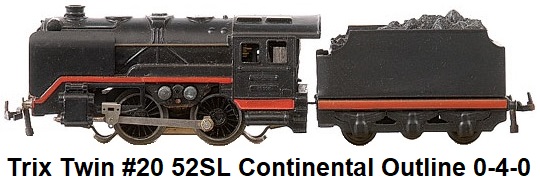 The British railway companies LNER, LMS, GWR, and Southern were nationalized in 1948 to become British Railways.
By 1950 the railway locos and rolling stock were all in British Railways livery with red and cream coaches, and green, blue, or black locos.
Ahead of their rivals, British Trix adopted the new BR liveries for their models, but the public wanted more realism in model design.
They were getting it from Hornby Dublo and Tri-ang
but not from Trix. Both of these rival manufacturers were using 12 volts DC. Rolling stock couplings in post-war were a tinplate hook designed
by the Peco company and were very similar to those used by Hornby Dublo. Because Trix wheels have large (coarse) flanges, Trix track points are
unsuitable for other manufacturers' rolling stock. In the late fifties, Trix started making 'Universal' points which were suitable for all makes.
Trix locos had a complex reversing mechanism, which made
production expensive and operation less reliable. The AC motor mechanism was fitted to 0-4-0, 4-4-0 and 2-4-2 locos, and also the Diesel Flyer,
The British railway companies LNER, LMS, GWR, and Southern were nationalized in 1948 to become British Railways.
By 1950 the railway locos and rolling stock were all in British Railways livery with red and cream coaches, and green, blue, or black locos.
Ahead of their rivals, British Trix adopted the new BR liveries for their models, but the public wanted more realism in model design.
They were getting it from Hornby Dublo and Tri-ang
but not from Trix. Both of these rival manufacturers were using 12 volts DC. Rolling stock couplings in post-war were a tinplate hook designed
by the Peco company and were very similar to those used by Hornby Dublo. Because Trix wheels have large (coarse) flanges, Trix track points are
unsuitable for other manufacturers' rolling stock. In the late fifties, Trix started making 'Universal' points which were suitable for all makes.
Trix locos had a complex reversing mechanism, which made
production expensive and operation less reliable. The AC motor mechanism was fitted to 0-4-0, 4-4-0 and 2-4-2 locos, and also the Diesel Flyer,
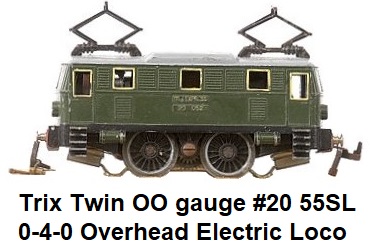 Meteor, and Southern Electric set. A deluxe version of the AC motor was manufactured in Germany and fitted in the 4-6-2 locos.
A change to 12 volt DC operation was finally made in 1956, but the models were still 3-rail and
more expensive than the other OO brands. In the late 1950's, Trix introduced a fine new range of realistic locos including Britannia Class V, and
EM1 Bo-Bo electrics. Between 1950 and 1956 Trix produced thousands of train sets.
By 1957 the British Trix group was failing and the Bing family sold the company to Ewart Holdings. Ewart Holdings collapsed a year later and a major creditor
named Dufay Ltd. took over the assets. Dufay relocated production to a facility in Birmingham and brought in Ernst Rozsa.
Poor sales caused the company to close down again in 1961 and a buyer was sought. In the mid-1960's Trix produced nicely detailed models of the
A4 Mallard in LNER blue (Trix 1190), the A4 Silver Link in LNER Grey (Trix 1188) and the A4 Merlin in BR Green (Trix 1195) for 2-rail DC.
By 1962 The company was sold to Alvus Investments and Trading who
planned to restart production of Trix in High Wycombe, but only the coach molding tools were made.
Meteor, and Southern Electric set. A deluxe version of the AC motor was manufactured in Germany and fitted in the 4-6-2 locos.
A change to 12 volt DC operation was finally made in 1956, but the models were still 3-rail and
more expensive than the other OO brands. In the late 1950's, Trix introduced a fine new range of realistic locos including Britannia Class V, and
EM1 Bo-Bo electrics. Between 1950 and 1956 Trix produced thousands of train sets.
By 1957 the British Trix group was failing and the Bing family sold the company to Ewart Holdings. Ewart Holdings collapsed a year later and a major creditor
named Dufay Ltd. took over the assets. Dufay relocated production to a facility in Birmingham and brought in Ernst Rozsa.
Poor sales caused the company to close down again in 1961 and a buyer was sought. In the mid-1960's Trix produced nicely detailed models of the
A4 Mallard in LNER blue (Trix 1190), the A4 Silver Link in LNER Grey (Trix 1188) and the A4 Merlin in BR Green (Trix 1195) for 2-rail DC.
By 1962 The company was sold to Alvus Investments and Trading who
planned to restart production of Trix in High Wycombe, but only the coach molding tools were made.


Over the years through the early 1960's, British Trix made coaches in 3 sizes. These were the 4-wheel short coaches, 8 wheel
short coaches, and the longer 'scale' coaches. 4-wheel short coaches were manufactured during the pre-World War II period. These came
in LMS and LNER livery. Most Trix coaches are the short bogie type
with 8 wheels, and were manufactured between approximately 1936 and 1958 in a variety of colors and liveries. These included LMS maroon, LNER 'teak'
brown, Southern Railways green, BR red and cream, BR maroon and Southern Region green. A Continental style green coach with a Paris-Basle sign on both sides
and a green coach with TTR on each side was also produced. The suburban bogie coach was made in BR red, BR maroon, and Engineer's black. A parcels coach was
made in BR red and BR maroon, and a special version was fitted with an electrically operated whistle. The longer Trix coaches were catalogued as 'Scale'.
These were also produced in a variety of colors to match the railway companies' liveries of the time. A Pullman coach was produced in brown and cream.
Some of the scale coaches are fitted with lighting with electrical pickup through brass wheels and a collector shoe. In the later 50's, Trix fitted
interior furniture to the scale coaches. Then the tinplate coaches were discontinued, and production in plastic continued to the 1970's.


Trix began to offer somewhat longer coaches that were also utilized as center cars with their Transpennine and MU trains. These were models of the
prototype British Railways Mark 1 (MK-1) sleeping cars built between 1957 and 1964. The models featured plastic bodies and were offered in blue/grey, SR green,
maroon, chocolate/cream, Transpennine green, SR blue, 'LMS' maroon, and 'GWR' chocolate/cream. Apart from being in 1:80 scale, which makes them noticeably
undersized against 4mm stock, these are nice looking, well executed coaches.
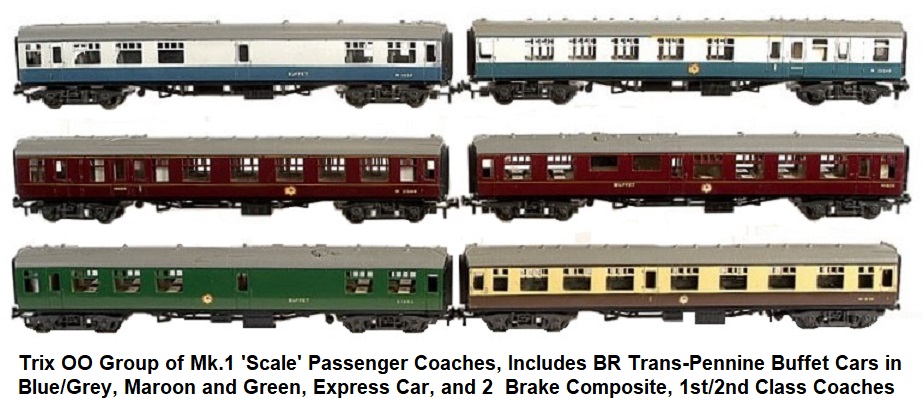
The majority of the Trix 4-wheel wagons were manufactured in tinplate in a variety of railway company liveries, including LMS,
LNER, Southern, and BR. Several of the early pre-war wagons have large LMS and NE lettering. In the early 1950's, the tinplate underframe that
had been used on wagons since the 1930's was replaced with a diecast frame. The first version of the cast frame did
not have tinplate brake gear, and was deeper with an extra row of rivets. These wagons are quite rare, but not valuable. At the end of the fifties,
Trix discontinued the tinplate-bodied wagons and started manufacturing wagons in plastic, with new cast frames. Later, the cast frames were replaced
with plastic, resulting in all-plastic rolling stock.

During the 1960's Trix had a contract to supply OO bulk grain whisky wagons to Tri-ang Hornby
for inclusion in the Tri-ang-Hornby range. Some models had a Tri-ang-Hornby chassis but a Trix body that was shorter than the Tri-ang Hornby chassis.
Eventually Tri-ang Hornby tooled up their own body as Trix could not supply all that was needed.
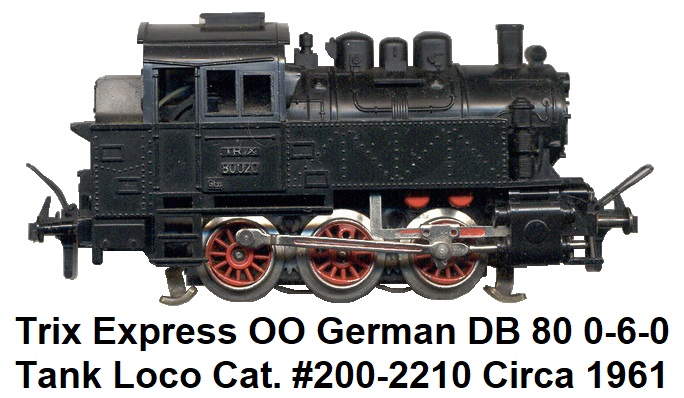 In 1963 British Celanese (part of the Courtaulds Group) formed British Trix and purchased the goodwill and patents of Trix Products
for £1 and a production base was set up at the British Celanese factory in Wrexham. Ernst Rozsa was placed in charge of design and development but later
took full responsibility for production. The decision was taken to dump the stocks of tinplate and 14V AC models and they were buried in a large hole on
the Wrexham factory site. To swell the range quickly a lot of models were bought in from Continental manufacturers and repackaged. 1964 was a good year
but by 1965 Courtaulds were inviting Lines Brothers to take Trix off their hands. Lines Bros. turned down the offer. Kit locomotives and rolling stock
were introduced that year and sold well and in 1967 N gauge Minitrix models for the British market were being made in the Wrexham factory. By the mid-sixties,
Trix was manufacturing many items in plastic, rather than the earlier diecast or tinplate. Despite a number
of successes, the financial problems continued and at the end of 1967 the plug was once again pulled. Quickly the German Trix company acquired the assets
of British Trix and a company called Thernglade was acquired to take over production. Rozsa was a Director of the new company and the product was renamed
‘Trix Trains’. This period was famed for the excellent LNER Pacific locomotives they produced in OO scale. In 1967 the 3-rail system was finally replaced by
the more realistic 2-rail track. Although the 3-rail range of items remained available to special order until 1972.
In 1963 British Celanese (part of the Courtaulds Group) formed British Trix and purchased the goodwill and patents of Trix Products
for £1 and a production base was set up at the British Celanese factory in Wrexham. Ernst Rozsa was placed in charge of design and development but later
took full responsibility for production. The decision was taken to dump the stocks of tinplate and 14V AC models and they were buried in a large hole on
the Wrexham factory site. To swell the range quickly a lot of models were bought in from Continental manufacturers and repackaged. 1964 was a good year
but by 1965 Courtaulds were inviting Lines Brothers to take Trix off their hands. Lines Bros. turned down the offer. Kit locomotives and rolling stock
were introduced that year and sold well and in 1967 N gauge Minitrix models for the British market were being made in the Wrexham factory. By the mid-sixties,
Trix was manufacturing many items in plastic, rather than the earlier diecast or tinplate. Despite a number
of successes, the financial problems continued and at the end of 1967 the plug was once again pulled. Quickly the German Trix company acquired the assets
of British Trix and a company called Thernglade was acquired to take over production. Rozsa was a Director of the new company and the product was renamed
‘Trix Trains’. This period was famed for the excellent LNER Pacific locomotives they produced in OO scale. In 1967 the 3-rail system was finally replaced by
the more realistic 2-rail track. Although the 3-rail range of items remained available to special order until 1972.



In 1971 a number of German toy company ownership
changes led to a decision to phase out model railway production at Wrexham. The Minitrix N gauge tools were bought by the German Trix company.
In 1973 Rovex Ltd became the importers of the range which was renamed Hornby Minitrix. Meanwhile Thernglade continued toy production until the factory
closed in 1973. Rozsa had salvaged the model railway side of the business and purchased stock and spares. He set up a mail order business under the name
Berwyn Hobbies Supplies while Liliput of Austria purchased the British model tools owned by Trix of Germany. In 1974 Ernst Rozsa
formed Liliput Model Railways (UK) and continued to assemble former British Trix models from parts supplied by Liliput. This continued until 1992 when the
supply of parts finally dried up. Over the years the Trix brand in the UK was taken over several times becoming Trix Twin Railways, Trix Trains,
and then merging with the Austrian manufacturer Liliput which
became part of Bachmann in 1992. Production of British Trix trains ceased in the mid 1970's. The spirit of British Trix could
still be found in Dapol and Bachmann models in 1994/5 that used ex-British Trix/Liliput molds and tooling. In 2003 the Trix Twin Railway Collectors Association
acquired some of the original molds when Dapol ceased production.
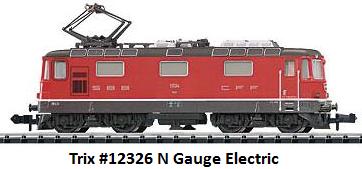 In 1938, Trix in Germany was acquired by Ernst Voelk, the President of the Chamber of Trade in Nürenburg and owner of
Distler, a long standing toy manufacturer. Voelk ran the company until 1962.
In 1939 German Trix introduced its line of electrical signals, remote control switches,
remote controlled uncoupling track, and a train control system.
In 1938, Trix in Germany was acquired by Ernst Voelk, the President of the Chamber of Trade in Nürenburg and owner of
Distler, a long standing toy manufacturer. Voelk ran the company until 1962.
In 1939 German Trix introduced its line of electrical signals, remote control switches,
remote controlled uncoupling track, and a train control system.
 Trix manufacturing plants in Germany had to change over to manufacturing armaments during the war for the
German Army. United was now manufacturing precision mechanical and thermoelectric devices. This included telegraph
and field telephone equipment. The plants in Nüremburg became targets for
Allied bombers. Trix relocated some of their manufacturing to a rural area in early 1943. In the spring of 1945 the Nürenberg,
Kobergerstrasse 15 plant was bombed and sustained heavy damage. Many of the handmade patterns were destroyed.
Trix manufacturing plants in Germany had to change over to manufacturing armaments during the war for the
German Army. United was now manufacturing precision mechanical and thermoelectric devices. This included telegraph
and field telephone equipment. The plants in Nüremburg became targets for
Allied bombers. Trix relocated some of their manufacturing to a rural area in early 1943. In the spring of 1945 the Nürenberg,
Kobergerstrasse 15 plant was bombed and sustained heavy damage. Many of the handmade patterns were destroyed.
Production resumed in 1948 in Germany but began to lag behind the technology used by rivals.
German Trix switched from AC to DC (with its simple reversing function) later than rivals like
Tri-ang, and the surviving British Trix company. In 1956
Trix switched to permanent magnet DC motors by replacing the field coil with a permanent bar magnet and replacing
the anchor and the brush holder for all existing models. In 1967 the changeover to two-rail operation, as used by most
competitors, was made. A popular item that Trix introduced at the Nürenberg Toy Fair in 1957 was the
reissue of the 2C1-speed train series of German Federal Railways based on the BR 01 4-6-2 first released by Trix Express in 1937.
 1962 marked the birth of modern N Scale when Karl Arnold & Co introduced their Rapido line.
At that time, Trix in Germany had already been competing with Lone Star Toys' Treble-O-Trains push-along toys, and were
developing electrically-powered N Scale trains of their own. 'N' gauge models under the Minitrix brand were made from the
late 1960's mostly of European prototypes
(German and British primarily). North American prototypes were also manufactured and marketed under the
Aurora Postage Stamp brand. Later these items were sold under the American Tortoise, Model Power
and Con-Cor brands. Trix sometimes utilized North American consultants to aid in the design of this
portion of the product line. The 'Hornby Minitrix' brand was used in the 1980's for a short lived range
of British outline models using the earlier product tooling. Selectrix, released in 1983, is the Trix Minitrix
proprietary Digital system that is fully compatible with standard DCC systems.
1962 marked the birth of modern N Scale when Karl Arnold & Co introduced their Rapido line.
At that time, Trix in Germany had already been competing with Lone Star Toys' Treble-O-Trains push-along toys, and were
developing electrically-powered N Scale trains of their own. 'N' gauge models under the Minitrix brand were made from the
late 1960's mostly of European prototypes
(German and British primarily). North American prototypes were also manufactured and marketed under the
Aurora Postage Stamp brand. Later these items were sold under the American Tortoise, Model Power
and Con-Cor brands. Trix sometimes utilized North American consultants to aid in the design of this
portion of the product line. The 'Hornby Minitrix' brand was used in the 1980's for a short lived range
of British outline models using the earlier product tooling. Selectrix, released in 1983, is the Trix Minitrix
proprietary Digital system that is fully compatible with standard DCC systems.
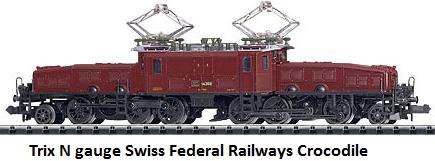 German Trix's owner in the 1980's and early 1990's was Mangold. Also for a brief period
in 1993 Gama-Schuco combined with Trix. In 1996, following their 60th anniversary,
two special versions of the BR 01 loco were issued as the TE 32223 and TE 32304 in green and gray livery.
Mangold went bankrupt in the late 1990's and
Märklin purchased the assets in January of 1997. In part,
this purchase was a reflection of Märklin's need for added production capacity as Trix had been manufacturing
certain items for Märklin in previous years. But the purchase was also in response to the earlier
purchase of the Karl Arnold company by
the Italian company Rivarossi. Ironically Märklin
had previously refused to make N Scale trains and instead launched Z Scale in 1972. The merger of these two
manufacturers enabled the development and advancement of Trix for producing DC trains in N and HO. However,
around this time production of North American models was halted. In 2003, Märklin
introduced its first 'N' gauge models under the Minitrix brand. Some of the more well known products were
the King Ludwig, the Wilhelm II set and the Adler set. All are now very expensive collectors
items. Several Märklin HO scale three-rail AC locomotives have also been introduced in two-rail DC versions under the Trix
logo.
German Trix's owner in the 1980's and early 1990's was Mangold. Also for a brief period
in 1993 Gama-Schuco combined with Trix. In 1996, following their 60th anniversary,
two special versions of the BR 01 loco were issued as the TE 32223 and TE 32304 in green and gray livery.
Mangold went bankrupt in the late 1990's and
Märklin purchased the assets in January of 1997. In part,
this purchase was a reflection of Märklin's need for added production capacity as Trix had been manufacturing
certain items for Märklin in previous years. But the purchase was also in response to the earlier
purchase of the Karl Arnold company by
the Italian company Rivarossi. Ironically Märklin
had previously refused to make N Scale trains and instead launched Z Scale in 1972. The merger of these two
manufacturers enabled the development and advancement of Trix for producing DC trains in N and HO. However,
around this time production of North American models was halted. In 2003, Märklin
introduced its first 'N' gauge models under the Minitrix brand. Some of the more well known products were
the King Ludwig, the Wilhelm II set and the Adler set. All are now very expensive collectors
items. Several Märklin HO scale three-rail AC locomotives have also been introduced in two-rail DC versions under the Trix
logo.

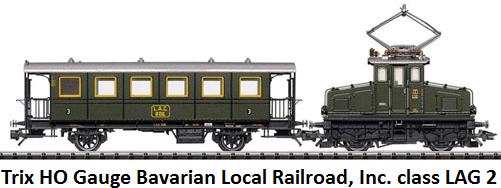 The Minitrix brand became very popular in the United States of America. In 2009
Walthers became the exclusive North American distributor for Trix products.
Märklin declared bankruptcy in 2009, but by 2010 was solvent again. 2012 saw production of new Trix 2-rail DC versions of
Märklin AC 3-rail equipment and several new models, including a number of Era I freight and passenger cars, plus a five-car DB
'Blauer Enzian' passenger set with observation cars at both ends (the original used former Henschell-Wegman equipment).
Märklin and its brands, including Trix Trains was acquired by the Simba Dickie Group in 2013.
The Minitrix brand became very popular in the United States of America. In 2009
Walthers became the exclusive North American distributor for Trix products.
Märklin declared bankruptcy in 2009, but by 2010 was solvent again. 2012 saw production of new Trix 2-rail DC versions of
Märklin AC 3-rail equipment and several new models, including a number of Era I freight and passenger cars, plus a five-car DB
'Blauer Enzian' passenger set with observation cars at both ends (the original used former Henschell-Wegman equipment).
Märklin and its brands, including Trix Trains was acquired by the Simba Dickie Group in 2013.
Besides the AC Trix Express and Minitrix brands, the Trix company is also well known for its 1:87 scale
DC brands, Trix International and Trix HO, dating back at least to the early 1970's and still being
produced today.
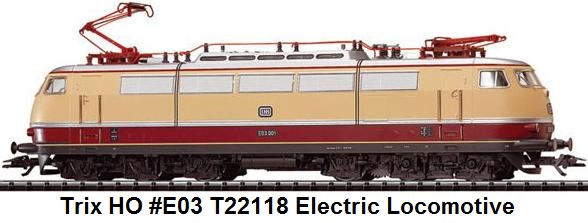 A particular Trix speciality is the reproduction of Bavarian prototype models from Epoch I and their
equivalent Epoch II, DRG versions. Examples such as the B VI (BR 34), D XI (BR 984-5),
D XII (BR 73), G 3/4 H (BR 54), Gt 2x4/4 (BR 96), P 3/5 H (BR 384), PtL 2/2 (BR 983)
and S 3/6 (BR 184) have been produced in the steam locomotive line, along with numerous
passenger and goods wagons.
A particular Trix speciality is the reproduction of Bavarian prototype models from Epoch I and their
equivalent Epoch II, DRG versions. Examples such as the B VI (BR 34), D XI (BR 984-5),
D XII (BR 73), G 3/4 H (BR 54), Gt 2x4/4 (BR 96), P 3/5 H (BR 384), PtL 2/2 (BR 983)
and S 3/6 (BR 184) have been produced in the steam locomotive line, along with numerous
passenger and goods wagons.
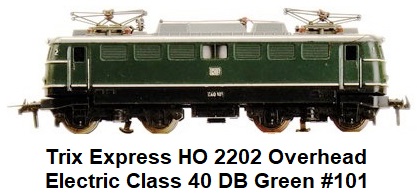 Trix Express locomotive and wagon models were assembled in Como Italy for the Rivarossi 2 rail system.
Trix also produced highly-detailed brass models of steam locomotives in limited quantities under
the "Fine Art" label in the late 1990's.
Trix Express locomotive and wagon models were assembled in Como Italy for the Rivarossi 2 rail system.
Trix also produced highly-detailed brass models of steam locomotives in limited quantities under
the "Fine Art" label in the late 1990's.
Detailed information on Trix can be found in the definitive reference book
"The History of Trix HO/OO Model Railways in Britain" by Tony Matthewman (New Cavendish Books, ISBN 0 904568 76 8,
now out of print). The late Tony Matthewman was a well-known Trix collector and expert. His extensive collection comprising a
large number of TTR items, was sold at Christie's Auction House in London in 1999. In addition, "The Bassett-Lowke Story" by
Roland Fuller (also published by New Cavendish Books) contains interesting information regarding the early years of Trix.
